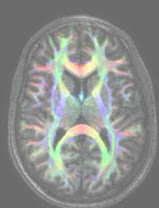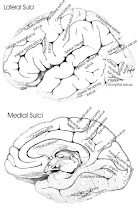PubMed Schizophrenia
Neuroanatomy of neurodevelopment psychiatric disoders
Cohesion of axonal organization in white matter of the central nervous system (ie brain and spinal cord in human).
Lloyd 2007

Brodmann Area
Areas 1, 2 & 3 - Primary Somatosensory Cortex (rostral to caudal is 3, 1, 2) -Homunculus representation: legs and trunk fold over midline; arms and hands (most tissue dedicated) are along middle of strip; face (with much tissue dedicated to lips) near bottom.
and hands (most tissue dedicated) are along middle of strip; face (with much tissue dedicated to lips) near bottom. 


 Area 4 - Primary Motor Cortex - motor homunculus
Area 4 - Primary Motor Cortex - motor homunculus 


Area 5 - Somatosensory Association Cortex

Area 6 - Pre-Motor and Supplementary Motor Cortex (may congtribute to planning of complex coordinated movements.)
Area 7 - Somatosensory Association Cortex (involved in locating objects in space; where vision and proprioception converge, enabling us to determine where objects are in relation to parts of the body. Generally, use in visuo-motor coordination such as in reaching to grasp an object).)
the body. Generally, use in visuo-motor coordination such as in reaching to grasp an object).)
Area 8 - Dorsolateral prefrontal cortex involved in management of uncertainty (increasing uncertainty increases activation here, fMRI). Hope occurs here, a high-order expectation positively correlated with uncertainty. This area also includes frontal eye fields where conscious control of eyes is believed to take place.
Hope occurs here, a high-order expectation positively correlated with uncertainty. This area also includes frontal eye fields where conscious control of eyes is believed to take place.
Area 9 - Dorsolateral prefrontal cortex - sustaining attention and working memory. Lesions cause difficulty in inhibiting responses.
Area 10 - Frontopolar area (involved in strategic processes of memory retrieval and executive function)
retrieval and executive function)
Area 11 - Orbitofrontal area (orbital and rectus gyri, plus part of the rostral part of the superior frontal gyrus). involved in planning, reasoning, and decision making. Perhaps the only cortical constraint of the hypothalamus.
part of the superior frontal gyrus). involved in planning, reasoning, and decision making. Perhaps the only cortical constraint of the hypothalamus.
Area 12 - Orbitofrontal area (used to be part of BA 11)
Area 13 - Insular cortex
Area 14 - Insular cortex
Area 15 - Anterior Temporal Lobe
Area 17 - Primary Visual Cortex (V1) - highly specialized for processing information about static and moving objects and is excellent in pattern recognition.
Area 18 - Secondary visual Association Cortex (V2) - bulk of the volume of the occipital lobe.
Area 19 - Tertiery visual association cortex (V3) - with area 18, involved in feature-extraction, shape recognition, and visual attention.
Area 20 - Inferior Temporal gyrus - high-level visual processes and recognition
Area 21 - Middle Temporal gyrus - auditory processing and language, notably left side
Area 22 - Superior Temporal Gyrus, includes Wernicke's area in its posterior. Left side involved in generation and understanding of words. Right side, melody, pitch, and sound intensity.
Area 23 - Ventral posterior cingulate cortex
Area 24 - Ventral anterior cingulate cortex - motivation, will
Area 25 - Subgenual cortex
Area 26 - Ectosplenial area
Area 28 - Posterior Entorhinal Cortex
Area 29 - Retrosplenial cingular cortex
Area 30 - Part of cingular cortex
Area 31 - Dorsal Posterior cingular cortex
Area 32 - Dorsal Anterior cingulate cortex
Area 34 - Anterior Entorhinal Cortex (part of parahippocampal gyrus)
Area 35 - Perirhinal cortex (part of parahippocampal gyrus)
Area 36 - Parahippocampal cortex (part of parahippocampal gyrus)
Area 37 - Fusiform gyrus
Area 38 - Temporopolar area - important area in self representation, semantic (left) and autobiographic (right)
Area 39 - Angular gyrus, part of Wernicke's area - reading, on left side grapheme-phoneme conversion; and general semantic involvement
Area 40 - Supramarginal gyrus part of Wernicke's area
Area 41 - Primary Auditory Cortex - conscious awareness of sound
Area 42 - Secondary Auditory Cortex
Area 43 - Subcentral area (between insula and post/precentral gyrus)
Area 44 - pars opercularis, part of Broca's area on left hemisphere
Area 45 - pars triangularis, part of Broca's area on left hemisphere
Area 46 - Dorsolateral prefrontal cortex
Area 47 - Inferior prefrontal gyrus - involved in syntactical processing
Area 48 - Retrosubicular area (a small part of the medial surface of the temporal lobe)
Area 52 - Parainsular area (at the junction of the temporal lobe and the insula)
Areas 1, 2 & 3 - Primary Somatosensory Cortex (rostral to caudal is 3, 1, 2) -Homunculus representation: legs and trunk fold over midline; arms
 and hands (most tissue dedicated) are along middle of strip; face (with much tissue dedicated to lips) near bottom.
and hands (most tissue dedicated) are along middle of strip; face (with much tissue dedicated to lips) near bottom. 


 Area 4 - Primary Motor Cortex - motor homunculus
Area 4 - Primary Motor Cortex - motor homunculus 


Area 5 - Somatosensory Association Cortex


Area 6 - Pre-Motor and Supplementary Motor Cortex (may congtribute to planning of complex coordinated movements.)

Area 7 - Somatosensory Association Cortex (involved in locating objects in space; where vision and proprioception converge, enabling us to determine where objects are in relation to parts of
 the body. Generally, use in visuo-motor coordination such as in reaching to grasp an object).)
the body. Generally, use in visuo-motor coordination such as in reaching to grasp an object).)
Area 8 - Dorsolateral prefrontal cortex involved in management of uncertainty (increasing uncertainty increases activation here, fMRI).
 Hope occurs here, a high-order expectation positively correlated with uncertainty. This area also includes frontal eye fields where conscious control of eyes is believed to take place.
Hope occurs here, a high-order expectation positively correlated with uncertainty. This area also includes frontal eye fields where conscious control of eyes is believed to take place.Area 9 - Dorsolateral prefrontal cortex - sustaining attention and working memory. Lesions cause difficulty in inhibiting responses.
Area 10 - Frontopolar area (involved in strategic processes of memory
 retrieval and executive function)
retrieval and executive function)Area 11 - Orbitofrontal area (orbital and rectus gyri, plus part of the rostral
 part of the superior frontal gyrus). involved in planning, reasoning, and decision making. Perhaps the only cortical constraint of the hypothalamus.
part of the superior frontal gyrus). involved in planning, reasoning, and decision making. Perhaps the only cortical constraint of the hypothalamus.Area 12 - Orbitofrontal area (used to be part of BA 11)
Area 13 - Insular cortex

Area 14 - Insular cortex

Area 15 - Anterior Temporal Lobe
Area 17 - Primary Visual Cortex (V1) - highly specialized for processing information about static and moving objects and is excellent in pattern recognition.
Area 18 - Secondary visual Association Cortex (V2) - bulk of the volume of the occipital lobe.
Area 19 - Tertiery visual association cortex (V3) - with area 18, involved in feature-extraction, shape recognition, and visual attention.
Area 20 - Inferior Temporal gyrus - high-level visual processes and recognition

Area 21 - Middle Temporal gyrus - auditory processing and language, notably left side
Area 22 - Superior Temporal Gyrus, includes Wernicke's area in its posterior. Left side involved in generation and understanding of words. Right side, melody, pitch, and sound intensity.
Area 23 - Ventral posterior cingulate cortex

Area 24 - Ventral anterior cingulate cortex - motivation, will
Area 25 - Subgenual cortex
Area 26 - Ectosplenial area
Area 28 - Posterior Entorhinal Cortex
Area 29 - Retrosplenial cingular cortex
Area 30 - Part of cingular cortex
Area 31 - Dorsal Posterior cingular cortex
Area 32 - Dorsal Anterior cingulate cortex
Area 34 - Anterior Entorhinal Cortex (part of parahippocampal gyrus)
Area 35 - Perirhinal cortex (part of parahippocampal gyrus)
Area 36 - Parahippocampal cortex (part of parahippocampal gyrus)
Area 37 - Fusiform gyrus
Area 38 - Temporopolar area - important area in self representation, semantic (left) and autobiographic (right)
Area 39 - Angular gyrus, part of Wernicke's area - reading, on left side grapheme-phoneme conversion; and general semantic involvement
Area 40 - Supramarginal gyrus part of Wernicke's area

Area 41 - Primary Auditory Cortex - conscious awareness of sound
Area 42 - Secondary Auditory Cortex
Area 43 - Subcentral area (between insula and post/precentral gyrus)
Area 44 - pars opercularis, part of Broca's area on left hemisphere

Area 45 - pars triangularis, part of Broca's area on left hemisphere
Area 46 - Dorsolateral prefrontal cortex
Area 47 - Inferior prefrontal gyrus - involved in syntactical processing
Area 48 - Retrosubicular area (a small part of the medial surface of the temporal lobe)
Area 52 - Parainsular area (at the junction of the temporal lobe and the insula)

Labels: Brodmann areas
Human brain, renderings from T1 weighted MRI, average of 27 scans (Colin, Montreal Neurological Institute) and conjunction with Brodmann areas
Labels: Brain pictures, Colin Brain
Subscribe to:
Posts (Atom)



